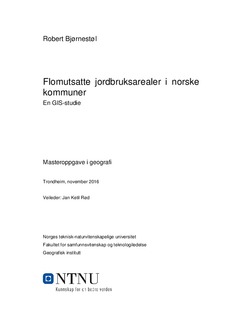| dc.description.abstract | We are expected to experience a change in the earth’s future climate. Among the expected effects of climate change, the increase in precipitation raises the most concern in Norway. An increase in precipitation can result in floods, and lead to agricultural land at risk of being damaged. This study has highlighted to what degree the agricultural land in Norwegian municipalities are exposed to floods. This is done by using zonal statistics to calculate how much of the agricultural land in each municipality that is situated in flood risk areas. Each municipality is rated and then ranked in an index with the relative degree of flood exposure. The index is based on a national flood risk map. It is the municipalities with the largest share of the agricultural land, situated in the flood risk areas, who gets the highest degree of exposure. The results show that the most exposed municipalities are situated around the country, and the municipalities who are most exposed are typically situated around the biggest rivers. Since the index is based on a national flood risk map, the information can be used to put attention on and lead to further discussion about where the most exposed agricultural land might be in the future. This can be done by doing more research on the identified exposed municipalities on a more local level. | nb_NO |
